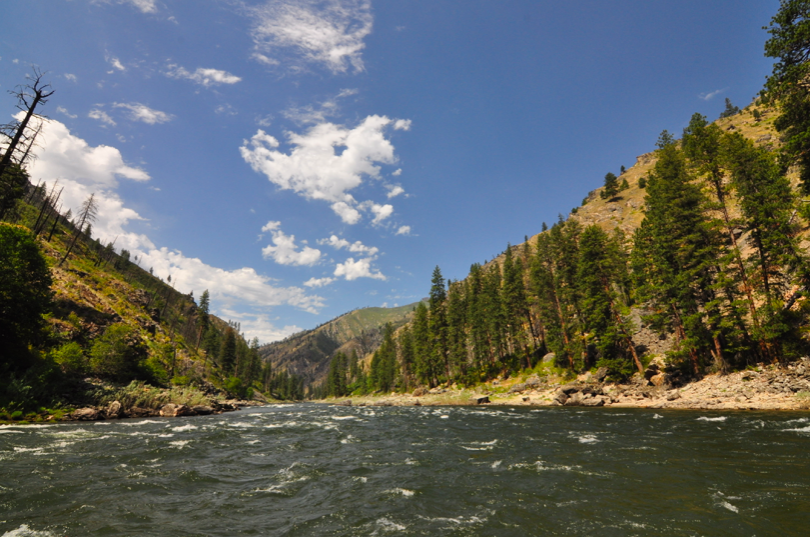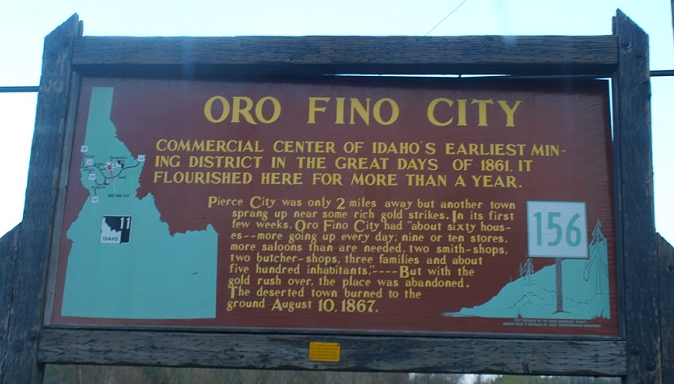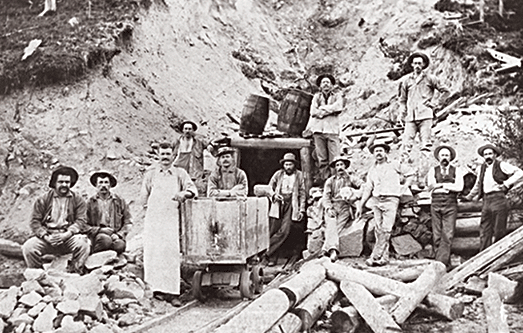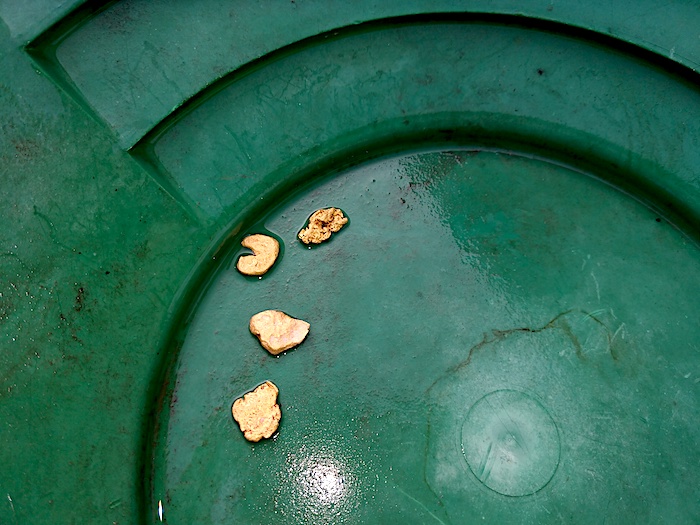
Discovery of Gold at Pierce
The initial discovery of gold in the Clearwater River region is credited to a group of prospectors led by E.D. Pierce in 1860. They found gold along Orofino Creek, a tributary of the Clearwater River. This was actually the first major gold rush in Idaho, and it brought miners deep into the rugged mountains of north and Central Idaho in search of riches.
As more gold was discovered in the area, Pierce grew rapidly. The town had a transient and rough character, with numerous saloons, hotels, and other businesses catering to the needs of miners.
Over time, mining techniques evolved from placer mining to lode mining, where gold was extracted from quartz veins within the bedrock. This transition required more advanced equipment and techniques to tunnel deep in the ground following the rich veins. The easy gold in the creek played out rather quickly, but the quartz veins would sustain the town for some time.
Orofino and the Gold Rush
The discovery of gold led to a rush of prospectors to the Clearwater River area, and the town of Orofino was established in 1861 to support the growing population of miners at Pierce and the surrounding mining camps.
Orofino quickly became a hub for gold mining activities, with miners using various techniques. Initially, prospectors engaged in placer mining, which involved panning or using simple equipment to extract gold from the gravels of streams and riverbeds. After a short time, more intensive methods like hydraulic mining were used to extract gold from the river and its tributaries.
Gold mining on the Clearwater River in Idaho has a rich history that dates back to the early 1860s when gold was first discovered in the area. 
South Fork Clearwater Gold
Gold was first discovered in the South Fork Clearwater River area during the 1860s, around the same time as the Pierce-Weippe Gold Rush. Prospectors, lured by the promise of gold, began to explore the river and its tributaries.
Several mining camps and settlements sprang up along the South Fork Clearwater River and its tributaries as prospectors sought their fortunes. These camps included places like Elk City and Dixie, where miners lived and worked.
Elk City became a major hub for the mines deep in the Clearwater country. As men ventured deeper into the wilderness, new sources of gold were discovered. The Buffalo Hump Mine, located near Elk City, is one of the most well-known and historically significant gold mines in the region. Gold was first discovered in the Buffalo Hump area in the 1860s.

In areas like Elk City and Dixie, the gold in the river was unprofitable to mine (by 1860’s standards) within a few years of their discovery. As better development came to the area, hard rock mines would become more established. In later decades almost all of the gold production in the Clearwater region was coming from lode mines.
The Bungalow Mine, also located near Elk City, was another notable gold mine in the area. Bear, Gold Hill, and Oro Grande mines also operated in this remote region.
All of these were lode mines that extracted gold from quartz deposits.
The mines operated on and off throughout the late 19th and early 20th centuries, with periods of prosperity and periods of decline.
There was good gold all throughout this country. In addition to the South Fork of the Clearwater River, extensive mining was also done on American River and Red River. If you explore this area today you will see miles and miles of old dredge tailings left behind by the bucket-line dredges.
Read: 12 of the Richest Gold Mining Locations in Idaho
Decline and Resurgence
Like many gold rushes, the initial enthusiasm and success of the Clearwater River gold rush began to wane as the easily accessible gold deposits were depleted.
However, gold mining in the area experienced a resurgence in the late 19th century with the advent of more advanced mining techniques, such as lode mining, and improved infrastructure, including the arrival of the railroad.
Interestingly, while the gold strike at Pierce was the first gold rush in Idaho, it took nearly 40 years for gold to be discovered in Murray, which is considered to be the last great gold rush in the lower-48 states.
Historical Significance
The Clearwater River gold rush is significant not only for its economic impact but also for its role in the history of Idaho and the American West.
The rush contributed to the growth and development of the region, leading to the establishment of towns, businesses, and infrastructure that had a lasting impact.
In the century that followed, logging would become the main economic engine of the region. While mining never completely died out, it slowed considerably after the initial decade of discovery. Stagnant metal prices and other challenges with operating mines in such a remote region would remain a major challenge.
Environmental Impact
Gold mining in the Clearwater River area, particularly hydraulic mining, had environmental consequences. Sediment and debris from mining operations affected the river’s water quality and ecosystem. The historic dredging operations also affected the water quality which was detrimental to the salmon and steelhead populations that the Clearwater is famous for.
It should be noted that modern suction dredges are very different from bucket-line dredges. While bucket-line dredges used a chain of massive cast iron bucket to dig up the riverbed, a suction dredge actually sucks up the gravel and runs it through a floating sluice box.
There has been some controversy in recent years about suction dredging on the Clearwater River. While there are legitimate concerns about the affect of dredging on fish, the fact is that this method has a limited season and has been highly regulated. In recent years, getting permitted to operation a dredge in Idaho has become extremely difficult. In my opinion, the impact caused by a small suction dredge is inconsequential in the grand scheme of things, but local environmental groups have jumped on it as a cause.

This is what many people think of when you mention dredging. This is a bucket-line dredge, not a suction dredge. They caused incredible destruction to riparian areas. In contrast, a suction dredge is much smaller, operated by one or two people and only impacts a very small area. The difference is night & day. This dredge is now abandoned and sits along the Yankee Fork.
Prospecting the Clearwater Region Today
Gold mining on the Clearwater River is much less prominent than it was during its heyday, but mining certainly still goes on even now. During the summer months, prospectors still explore the banks of the Clearwater River in search of gold.
The area around Elk City still gets a lot of attention from miners. The South Fork of the Clearwater, American River and Red River still have placer gold that can be panned and sluiced from the gravel bars.
How much gold can you find? This is always the question, and the only way to truly find out is to go and look for yourself. You might spend all weekend and not find a speck, or you may get lucky and find that once-in-a-lifetime nugget!
The best areas to search are generally the same areas where the “old timers” looked for gold. They didn’t find it all, so finding the evidence of past mining activity is a great way to start your hunt. Just be wary that there are still active mining claims in the area. It is also advised that you stay above ground and stay out of old mines! They are notoriously unstable and should be avoided.

You can buy cool gold nuggets and gold nugget jewelry from Slab Creek Designs.
More about gold in Idaho:
Early Gold Mining Efforts along the Snake River Warren, Idaho | Early History of a Booming Gold Rush Town The Rich Silver Ore in the Mountains of Silver City The Silver Mines of Bayhorse Boise Basin – The Largest Gold Strike in Idaho
